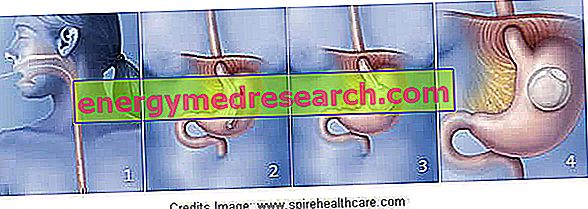Generality
The intragastric balloon (BIB) is a temporary treatment that allows you to get a weight loss without resorting to surgery.
The BIB ( Bioenterics Intragastric Balloon ) is a soft and expandable device, which is inserted into the patient's stomach by an endoscopic procedure, and filled there with a sterile physiological solution. Balloon placement is usually performed with the patient in a sedation state, so general anesthesia is not required.
The intragastric balloon partially fills the stomach and induces a feeling of premature satiety. Therefore, the BIB helps to reduce - or in any case control - the portions of the food consumed and, in association with the appropriate behavioral changes, represents a non-surgical method suitable for combating obesity.

What is an intragastric balloon?
An intragastric balloon is a prosthetic device that, for several years, has been used successfully as an adjunct for weight loss in moderately obese patients. The BIB consists of a soft and expandable elastomer material, which is inserted into the stomach with an endoscopic procedure and, subsequently, filled with physiological solution. The intragastric balloon thus filled partially occupies the stomach, leaving less space for the amount of food or drink ingested. This device therefore aims to reduce the feeling of hunger and helps you feel full longer, even after eating small meals. Sometimes, the intragastric balloon is used for severely obese patients who need short-term care to reduce their weight, up to a value that makes them suitable for a more complex and permanent surgical approach, such as a gastric band or gastric bypass .
Action Mechanism
The basic principle of BIB is the stimulation of the gastric fundus, the upper part of the stomach which is particularly rich in receptors, which once stimulated by the balloon (or by physiological food-induced gastric dilatation) send the satiety signal to the nervous system. Furthermore, the partial occupation of the gastric volume also mechanically reduces the amount of food the patient is able to ingest.
Indications
The intragastric balloon was designed for people who failed to achieve prolonged weight loss with conventional means, such as diet - possibly supported by supplements to lose weight - physical activity and any medications. The balloon is indicated for patients with a high body mass index or who have other diseases related to obesity. The gastric balloon is a non-permanent solution and is usually left in place for up to six months, after which it is removed. The technique has also been used successfully to induce some weight loss before subjecting the obese patient to a bariatric surgical procedure. Individuals who present only a slight overweight should NOT consider the intragastric balloon as a simple and effective solution to lose weight; rather, they should insist on tackling their problem with diet and exercise.
Contraindications
Intragastric balloon placement may not be suitable for patients with:
- Any illness and inflammatory condition of the gastrointestinal tract, such as: inflammation of the esophagus, ulcerations of the stomach or duodenum, gastroesophageal reflux disease, chronic intestinal inflammation, stenosis of the esophagus or throat, tumors or tendency to gastritis (the balloon may worsen the condition and cause excessive bleeding);
- Conditions that predispose to bleeding (for example: varicose veins) or who suffer from coagulation disorders;
- Hiatal hernia> 4-5 cm;
- Previous gastric surgery;
- Patients with severe liver disease;
- Alcoholism or drug addiction;
- Patients on long-term anticoagulation or with gastrolesive drugs;
- Women who are pregnant or breastfeeding.
Other contraindications to the BIB positioning intervention are:
- Crohn's disease (increases the risk of bowel obstruction);
- Patients taking non-steroidal anti-inflammatory drugs (for conditions such as osteoarthritis);
- Psychiatric or psychologically unstable patients (the high incidence of intolerance in these subjects makes it necessary to remove BIB prematurely);
- Patients with binge eating disorder (Binge Eating Disorder, BED, is a predictive factor for negative outcomes of the method).
The procedure
After the patient's sedation, the deflated intragastric balloon is inserted through the mouth and the esophagus directly into the stomach, just like when performing a gastroscopy. The surgeon can initially look at the stomach through an endoscopic camera and, if there are no anomalies that could influence the operation, proceed with the positioning of the device. The swallowing process is made easier with the help of a spray anesthetic, applied locally to numb the throat area. Once the balloon is in the correct position inside the stomach, it is immediately filled with a sterile physiological solution through a small filling catheter attached to the balloon. The catheter is then gently removed by pulling the outer end. The BIB closes automatically, as it is equipped with a self-sealing valve. The full balloon is too large to pass into the intestine and will float freely in the gastric cavity.
The duration of the procedure is variable, but generally takes about 20-30 minutes. The purpose of this mass is to produce an "artificial" feeling of satiety in the stomach and reduce the patient's ability to consume large amounts of food or liquid during a meal. The BIB system is a relatively minor intervention, but it may take some time for the stomach to get used to the device. Usually, the patient is able to return home the same day or after a short monitoring period. The competent specialist is able to provide support and advice after the intervention, in addition to defining the best treatment line, assessing weight loss and verifying patient tolerance towards the diet.
Note . A variant of the BIB is called Heliosphere Bag (BAG, Heliosphere Air Filled Gastric Balloon) and consists of a balloon made of an inert biocompatible material, filled with air.
Recovery after surgery
Immediately after the intragastric balloon is inserted into the stomach, it is necessary to limit the intake of oral fluids, which for this reason will be administered intravenously and replaced gradually with the normal oral intake. The first few days may be associated with a certain discomfort: for many patients, it is common to experience nausea, vomiting, swelling, diarrhea and cramps, until their body adapts completely to the presence of the intragastric balloon. Symptoms can last up to two weeks and some medications may be prescribed to help alleviate them. For the first three days following the procedure, all patients are strictly limited to a liquid diet, namely: water, fruit juice, milk or soup. Gradually, the ability to tolerate solid foods should improve, although the volume of food the patient is able to consume in a single intake must be substantially reduced and the appropriate dietary guidelines must be followed. Depending on the level of nausea, the patient can be discharged the day after the surgery or after a longer stay (about 2-4 days). In the first days of recovery, patients are advised to avoid any activity that could cause excessive pressure or trauma to the abdominal area. Some individuals may not be able to tolerate the balloon for the entire period (equal to six months) and, when this happens, the device must be removed earlier than established. There is a possibility that this intolerance may also occur in the first few days after the balloon is placed, especially if the side effects (including nausea and vomiting) do not resolve or appear more severe than expected. After the surgery, patients can return to their work after about 7 days of rest, but they must refrain from any physical exercise for at least 8 weeks.
Results
The weight loss that is obtained is variable and, initially, it can be quite rapid. Indicatively, the average weight loss achieved during the 6 months of maintenance of the intragastric balloon is about 15-20 kg. Ultimately, the extent of weight loss depends on patient compliance, that is, on the degree of adherence to a controlled diet and a program that allows you to change your lifestyle, starting with the practice of regular exercise.
Balloon removal
The BIB can be used for up to six months, longer periods are not recommended. Over time, in fact, the acid content of the stomach tends to weaken the material that constitutes the balloon and can deflate it. If it is considered necessary to use the intragastric balloon for more than 6 months, the patient may undergo a replacement operation. During maintenance of the BIB in situ, it may be necessary to follow an oral drug therapy in order to reduce the acidity of the stomach. This can lower the risk of irritation of the gastric cavity and any damage to the balloon.
At the end of the initial period, equal to 6 months, the competent surgeon can evaluate the options for the next phase (replacement with a new BIB or surgical procedure). The intragastric balloon is normally removed in the same way it was placed, through the esophagus and the mouth. Before removal, a sedative and a local anesthetic are administered to numb the throat. Using an endoscopic camera the doctor will introduce a catheter through the mouth to the stomach. The balloon is then perforated. Once deflated, it can be grasped by forceps and removed from the stomach.
Advantages
Compared to a gastric bypass operation or gastric band operation, inserting the balloon into the stomach has the following advantages:
- The technique is less invasive and generally does not require the patient to undergo surgery under general anesthesia;
- The procedure is much less expensive, because it does not involve anesthetics or prolonged hospitalizations;
- The procedure is easily reversible;
- Many patients achieve satisfactory weight loss in the period (around 6 months) when the intragastric balloon is kept in the stomach, provided they follow a reduced calorie diet and regular physical activity.
Disadvantages
All medical procedures have some disadvantages and can cause side effects; this rule does not miss the intragastric balloon positioning, which, however, presents a lower risk of complications compared to other more invasive bariatric surgery procedures.
risks
On rare occasions, the intragastric balloon can deflate and / or migrate through the stomach and intestines. In this case it will be easy to detect it, as the saline solution contains a dye (methylene blue) that facilitates early identification through a change in urine color. The patient must seek immediate medical assistance in removing the balloon, as a damaged or deflated device can lead to erosion or gastrointestinal obstructions, which can have very serious consequences. Although intragastric balloon placement procedures are performed regularly without complications, it is very important that all candidates are fully aware of the benefits and potential risks before undertaking this type of intervention.
Minor complications
- Pain, nausea and, in some cases, vomiting, occur in most patients within a few hours of balloon insertion. Some medications can be prescribed to reduce these side effects, which however usually resolve spontaneously within a few days. If these symptoms persist, they can cause dehydration and lead to further complications.
- There may be an increased incidence of gastrointestinal problems, such as gastric ulcers (erosions in the lining of the digestive tract).
- Some patients do not achieve the desired weight loss after intragastric balloon placement. In many cases, this is due to the early removal of the balloon due to psychological intolerance or lack of adherence to the prescribed diet.
Major complications
Lesions of the esophagus or stomach
As with other gastric procedures, there is a risk of injury to the lining of the digestive tract, either by direct contact with the instruments used to position the balloon, or as a result of increased production of gastric acids. This could lead to the formation of ulcers, pain, internal bleeding or perforation. Perforation is a serious complication that normally requires emergency surgery and could be fatal, especially in obese patients.
Intestinal obstruction
The most serious complication is the risk of intestinal obstruction. If the intragastric balloon deflates, it can be pushed into the intestine and advance to the rectum without problems; given its small size, it will then be eliminated through the faeces. However, in some cases it can block in the intestine causing an intestinal obstruction, with serious consequences for health.



